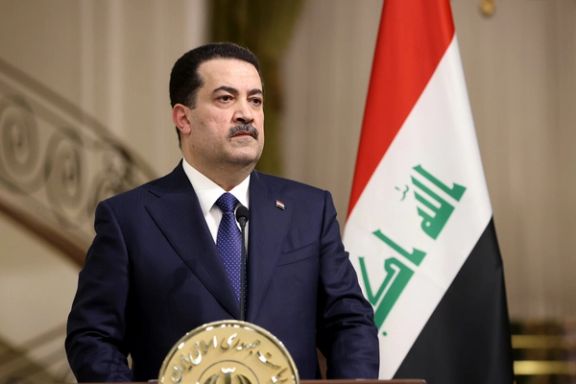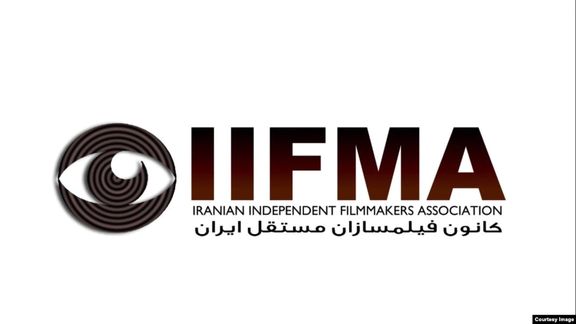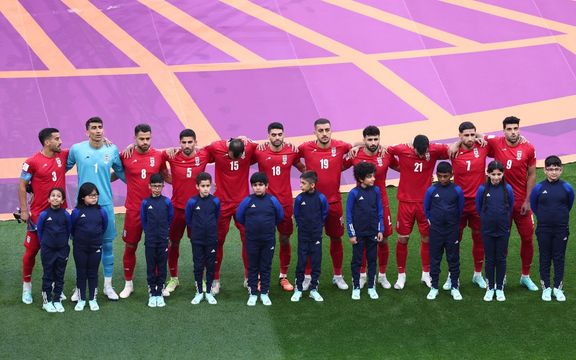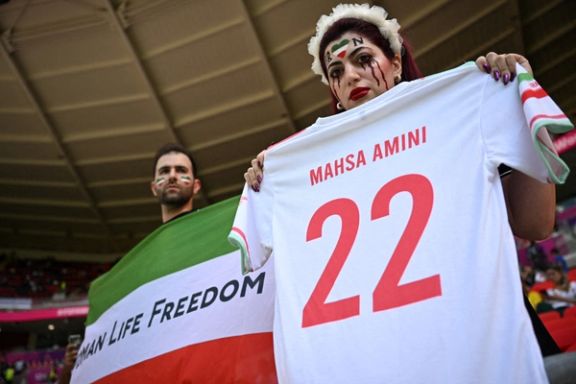Iran Should Stop Providing Russia With Ammunition: NATO

NATO has warned the Islamic Republic that it should not provide Moscow with arms and ammunition in its war against Ukraine.

NATO has warned the Islamic Republic that it should not provide Moscow with arms and ammunition in its war against Ukraine.
At a meeting of foreign ministers of the defense alliance’s members in Bucharest on Tuesday, NATO Secretary-General Jens Stoltenberg said Russia has asked Iran to provide it with weapons because it was “running low on ammunitions.”
“We are saying very clearly that no country should support Russia’s illegal war, and therefore, Iran and no other country should provide Russia with missiles, drones or anything else that can help them to continue this brutal war of aggression against Ukraine,” added Stoltenberg.
He further noted that Iran and no other country should provide Russia with “missiles, drones or anything else that can help them to continue this brutal war of aggression against Ukraine.”
Elsewhere in his remarks, Stoltenberg stated that Vladimir Putin's brutal invasion of Ukraine is failing in Ukraine.
Russia has been using Iranian drones in its air attacks against the Ukrainians. In October and November, it targeted Ukraine’s civilian energy infrastructure, plunging it into blackouts as the winter cold has begun across the country. Amid international outcry over the Islamic Republic’s supply of drones for the Russian invasion, Ukrainian President Volodymyr Zelenskiy told a meeting of UN security council November 23, that the attacks are “an obvious crime against humanity” adding that Kyiv would put forward a resolution condemning “any forms of energy terror”.

A Revolutionary Court of the Islamic Republic will try ten adolescent protesters Wednesday on charges of “war against God, corruption on earth and murder” that can carry the death sentence.
The move has led to widespread objections as several activists and organizations have expressed deep concern.
A committee monitoring the situation of recent protest detainees said, “these children are not having their own defense teams and lawyers appointed by the judiciary are supposed to represent them.”
A law in Iran forbids those charged with political crimes to hire their own lawyers.
They are charged in the death of a Basij militia member during protests on November 3 in Karaj west of Tehran.
Mohsen Borhani, a lawyer, and professor at Tehran University, had earlier warned about the trial of several detained minors in revolutionary courts.
During the popular uprising in Iran, over 18,000 citizens have been arrested and some of them were accused of “corruption on earth” and “war against God” which may carry the death penalty.
On Tuesday, Amnesty International called on governments with embassies in Iran to send observers to ongoing trials where protesters are at risk of being sentenced to death.
Amnesty said in a tweet this includes a group trial starting November 30 of 11 people, before Branch 1 of Revolutionary Court in Alborz.
“Amnesty is also extremely concerned at reports indicating children are among those at risk of being sentenced to death in mass trials in connection with protests, which would be a flagrant violation of international law,” it added in a statement.

While Iran’s IRGC has launched missile attacks on Iraq’s Kurdistan region, Iraqi Prime Minister says his government will not allow its territory to be used to “harm any side.”
Mohammed Shia' Al Sudani made the comments Tuesday in a meeting with Iranian President Ebrahim Raisi as part of his visit to the Iranian capital.
The Iraqi official said, “It is the policy of the Iraqi government that this country should not be the starting point for actions harming the countries of the region.”
In the meeting, Ebrahim Raisi claimed the Islamic Republic supports a united and strong government in Iraq.
Raisi said relations between Tehran and Baghdad must be expanded to establish more peace and stability in the region and the world.
Since the eruption of nationwide protests in Iran, regime officials have accused Kurdish opposition groups in northern Iraq of fueling the unrest, with the IRGC repeatedly launching deadly attacks on the neighboring country’s northern territories.
The latest round of shelling of Iraqi Kurdistan region drew condemnation by Western countries as well as the Iraqi government.
Iraqi Foreign Minister Fuad Hussein decried the attacks as a violation of Iraq's sovereignty and Kurdistan Region Prime Minister Masrour Barzani also condemned the “violations” of Iraq and its Kurdish region’s sovereignty.
The US also strongly condemned Iran’s “violations of Iraqi sovereignty”, calling on the Islamic Republic to stop attacking its neighbor.

The Israeli Air Force will hold large joint drills with the United States to simulate strikes against Iran’s nuclear program.
Releasing a statement on Tuesday, the Israel Defense Forces announced that the joint aerial wargames with the US military is to practice strikes against the Islamic Republic and its proxies in the region.
The two-day drills will be launched on Tuesday over parts of Israel and theMediterranean Sea, and include long-range flights needed by Israeli pilots to undertake to reach Iran.
The maneuvers come after IDF chief Aviv Kohavi visited the USlast week urging the defense officials that the two countries must speed up joint plans for offensive actions against Iran.
“In order to improve our capabilities in the face of challenges in the region, joint activity with the US Central Command will be significantly expanded in the near future,” Kohavi said after returning to Israel.
The Islamic Republic began enriching uranium to 60% purity at its Fordow nuclear plant last week, saying the move was in response to the resolution criticizing its lack of cooperation with the IAEA.
That purity is below the 90% needed for weapons-grade material but well above the 20% Iran produced before its 2015 agreement with major powers that capped enrichment at 3.67%.

A group of Iranian filmmakers have formed a new entity called “Iranian Independent Filmmakers Association” in support of the antigovernment protest movement.
In their statement on Monday four issues have been raised as the goals of the association.
Preventing repression and violence against peaceful protesters and innocent children, unconditional release of prisoners, drawing the attention of the world's filmmakers to events in Iran and “exposing the tactics of propaganda machine of the Islamic regime” are announced as the main goals of the group.
“Iranian protesters chant ‘Women, Freedom, Life’ and are being beaten, shot, arrested, tortured, and executed in every corner of their country by regime’s security forces. During this fateful and historical time, we, a group of independent filmmakers, who believe in the universal language of cinema as a powerful narrator of truth and peace, have come together to seek [our objective],” reads the statement.
The government tried to influence and control official associations representing filmmakers, artists or professionals.
Adeleh Cheraghi, one of the spokespersons of this association, told BBC Farsi that so far more than fifty Iranian filmmakers have become members of the group, including Shirin Neshat, Mostafa Azizi, Abdul Reza Kahani, Nima Sarvestani, Kaveh Farnam and Ali Abbasi.
According to her, the names of some members of the association will be published later “due to the existing security conditions and repression” inside and outside Iran.

Why Iran’s football (soccer) team in Qatar refused to sing the national anthem in its first game, which was their subtle gesture amid popular protests.
Every country has national symbols that represent its rich culture and history, traditions, and unique attributes of the land and its people. The national anthem is one such symbol that evokes feelings of patriotism among the citizens, binds them with a united purpose and collective identity, and reminds them of what they perceive as their nation's glorious heritage. It is nearly universal that national anthems demand reverence and are viewed by many as a sacred representation of their nation. It is common to see people rise and place a hand on their heart to show their commitment to their land and display their patriotism as they hear their anthem performed.
As Iran’s widespread protests enter their third month, there is an unusual phenomenon that is visible on the world stage. Many Iranians are distancing themselves from their national anthem. Iranian athletes competing in national and international arenas have chosen silence and adopted a posture of mourning during the opening ceremonies with the anthem playing. In none of the clips of popular unrests emerging from Iran has the anthem been featured or chanted. It may seem out of place that a movement of freedom for Iran would eschew what is supposed to be a symbol of national unity. But a review of the history of this anthem adopted in 1990 by the Islamic Republic provides clues as to why Iranians have moved away from this “national symbol.”
The current national anthem of Iran is the third anthem adopted by the Islamic Republic since the 1979 revolution. For three months after the revolution, “Ey Iran” was the anthem which was non-political and non-religious and recounted the history, beauty, resilience, and culture of Iran. Subsequently, to promote the identity of the Islamic Republic, another anthem entitled “Payandeh Bada Iran” was adopted that celebrated the achievements of the Revolution. After the end of the Iran-Iraq war in 1988 and the death of Supreme Leader Ayatollah Ruhollah Khomeini in 1989, a competition was announced for a new national anthem to raise the spirits of the war torn and mournful nation. This led to the adoption in 1990 of “Sorude Melliye Jomhuriye Eslamiye Iran” which translates as the National Anthem of the Islamic Republic of Iran.

The current anthem is short. The translation of the lyrics are as follows:
“Above the horizon rises the Eastern Sun,
The light in the eyes of the believers in truth,
The month of Bahman the pride of our faith,
Your message, O Imam [Khomeini], of independence and freedom is imprinted on our souls.
O martyrs! Your clamors echo in the ears of time:
May you endure eternally,
The Islamic Republic of Iran!”
In reviewing the lyrics, the only symbolism that celebrates the heritage of the nation is the Eastern Sun. The reference to the Sun has literary and cultural implications to the land, its calendar, and its history. But the rest of the lyrics depart from Iran’s national identity and focuses on the events and figures relating to the 1979 Revolution and its aftermath.
Since nature of the revolution was Islamic, the Sun in the first line ends up only illuminating the “eyes of believers in truth” thereby disregarding those who may believe differently than the ruling power apparatus. The month of Bahman overlaps with February, and this is a reference to the February 1st, 1979, return of the Ayatollah to Iran and the February 11th declaration of the victory of the Islamic Revolution. Why would a calendar month be represented as the pride of one’s faith? This cannot be simply faith in Islam or in the nation. This is faith in the Islamic Republic whose inception was in that fateful February (Bahman) of 1979. This further narrows the people for whom the anthem is meaningful.
In the lyrics, we come across a specific reference to Ayatollah Khomeini and a focus on his message of Independence and Freedom. Nearly 44 years have elapsed since those promises were made, and Iranians today feel that the message of the Ayatollah was only a mirage as Iran today is neither independent nor free by any stretch of the imagination.
The final part of the lyrics places words in the mouths of the fallen soldiers of the Iran-Iraq war of 1980-88. The fallen soldiers, referenced as martyrs, fought for Iran and its territorial integrity. But in a distortion of history, the lyrics suggest that their voices echo in the ears of time to eternally preserve the “Islamic Republic” rather than the nation of Iran. The sons and daughters of fallen soldiers have taken to social media to refute this notion. Additionally, the current system of government in Iran does not bear any of the hallmarks of a republic.
The sustained voices of the people of Iran are loud and clear. They want regime change. They do not wish to have a dictator as a Supreme Leader. They no longer wish to live under the Islamic Republic with its unsustainable policies within Iran and its ill-conceived engagement with the world. So, it is no surprise that an anthem that limits Iran’s definition to the confines of a particular ideology called the “Islamic Republic”, disregards its symbolism and heritage, overlooks its ancient history, and celebrates a figure with hollow promises, is mere propaganda to the Iranians rather than a symbol of national unity.
Nizam Missaghi is an Iranian-American physician. Due to being denied access to higher education under the Islamic Republic, he left Iran at 18 to pursue his education. He currently practices in the US and is also a clinical assistant professor of anesthesiology at the University of Arizona School of Medicine. He serves on the board of Iran Human Rights Documentation Center and has delivered lectures and written articles on Iran related topics.
The opinions expressed by the author are not necessarily the views of Iran International